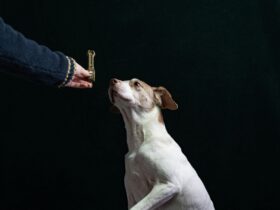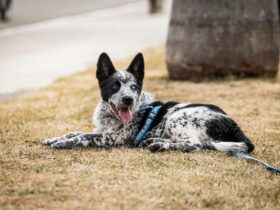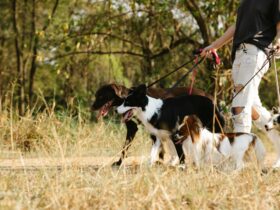Introduction
Scent training is a highly beneficial and mentally stimulating activity for dogs, tapping into their natural instincts. This form of training not only strengthens the bond between you and your dog but also provides a productive outlet for their energy. Whether you want to train your dog for professional scent work or simply for fun, this guide will walk you through everything you need to know to get started.
What Is Scent Training?
Scent training, also known as nose work, is a training activity where dogs are taught to use their sense of smell to locate specific objects or scents. This training is rooted in the natural ability of dogs to detect scents far better than humans, thanks to their highly developed olfactory system. In scent training, dogs learn to associate a specific smell with a reward, leading them to actively search for that scent in various environments.
The Science Behind a Dog’s Nose
A dog’s sense of smell is estimated to be between 10,000 to 100,000 times more acute than a human’s. This incredible ability is due to several factors:
- Olfactory Receptors: Dogs have over 300 million olfactory receptors in their noses, compared to about 6 million in humans.
- Olfactory Bulb: The part of a dog’s brain dedicated to analyzing scents is proportionally 40 times larger than that of a human.
- Airway Structure: Dogs can inhale and exhale simultaneously, allowing them to take in new scents while clearing old ones.
Benefits of Scent Training
Scent training offers a myriad of benefits for both dogs and their owners:
- Mental Stimulation: Scent training keeps your dog’s mind active, preventing boredom and reducing destructive behaviors.
- Physical Exercise: Searching for scents can be physically demanding, providing a good workout.
- Bonding: Working together on scent training strengthens the bond between you and your dog.
- Confidence Building: Successfully finding scents can boost a dog’s confidence, especially in nervous or shy dogs.
- Natural Instincts: It taps into and enhances a dog’s natural instincts, making it an enjoyable and fulfilling activity.
Types of Scent Training
There are several different types of scent training, each with its unique focus:
- Basic Scent Detection: The foundation of all scent work, where dogs are trained to locate a specific scent.
- Tracking: Dogs follow a scent trail left by a person or animal. Often used in search and rescue.
- Detection Work: Professional scent work where dogs are trained to detect substances like drugs, explosives, or even medical conditions.
- Search and Rescue: Dogs are trained to locate people, whether in wilderness settings or disaster areas.
- Scent Games: Fun and interactive games that you can play with your dog at home, using scent detection techniques.
Getting Started with Scent Training
Step 1: Choose a Scent
The first step in scent training is selecting a scent for your dog to detect. Common choices include:
- Essential Oils: Lavender, birch, and anise are popular in nose work.
- Food Items: Treats, cheese, or kibble can be used for beginners.
- Toys: You can use a specific toy with a distinct smell.
Step 2: Gather Your Supplies
Before starting, gather the necessary supplies:
- Scent Source: The item or substance you want your dog to find.
- Containers: Small boxes or tubes to hide the scent in.
- Treats or Rewards: High-value treats or a favorite toy to reward your dog.
- Leash and Harness: For controlling your dog during training.
- Clicker: (Optional) Used in clicker training to mark the correct behavior.
Step 3: Create a Positive Association
Begin by creating a positive association between the chosen scent and a reward. Follow these steps:
- Introduce the Scent: Allow your dog to sniff the scent source, and immediately reward them with a treat or praise.
- Repeat: Repeat this several times until your dog shows excitement when presented with the scent.
- Increase Complexity: Gradually increase the distance between your dog and the scent source before rewarding them.
Step 4: Start Basic Scent Work
Once your dog associates the scent with a reward, you can start basic scent work:
- Hide the Scent: Place the scent source in an easy-to-find location while your dog watches.
- Command: Use a command like “Find it!” to encourage your dog to locate the scent.
- Reward: Once your dog finds the scent, immediately reward them.
Step 5: Increase the Challenge
As your dog becomes more skilled, increase the difficulty:
- Hide the Scent Out of Sight: Start placing the scent in harder-to-find locations, like under furniture or behind objects.
- Use Multiple Scents: Introduce different scents and train your dog to identify each one by name.
- Increase the Area: Gradually increase the area in which your dog has to search.
Advanced Scent Training Techniques
For those looking to take scent training to the next level, consider these advanced techniques:
- Discrimination Training: Teach your dog to differentiate between multiple scents and respond only to the correct one.
- Scent Trails: Create scent trails by dragging the scent source along the ground and have your dog follow it to the end.
- Multiple Hides: Hide several scent sources in a large area and challenge your dog to find them all.
- Timed Searches: Introduce a timer to create a sense of urgency and challenge your dog’s speed.
Troubleshooting Common Issues
Scent training can come with challenges. Here’s how to troubleshoot common problems:
- Lack of Interest: If your dog isn’t interested, try using a more enticing reward or a different scent.
- Difficulty Finding Scent: Go back to easier searches and slowly increase difficulty again.
- Distraction: Train in a quiet environment and gradually introduce distractions as your dog improves.
- Over-Excitement: If your dog becomes too excited, use calming techniques like slow petting or deep breathing exercises.
Safety Tips for Scent Training
Always prioritize your dog’s safety during scent training:
- Avoid Harmful Scents: Ensure the scents you use are safe and non-toxic for dogs.
- Monitor Your Dog: Always supervise your dog during training to prevent ingestion of the scent source.
- Use Appropriate Rewards: Avoid overfeeding treats; consider using healthy options.
- Hydration: Make sure your dog has access to water, especially during outdoor searches.
- Physical Limitations: Consider your dog’s physical condition and avoid overly strenuous activities if they have health issues.
Incorporating Scent Training into Daily Life
Scent training doesn’t have to be a standalone activity; you can incorporate it into your dog’s daily routine:
- Scent Walks: During regular walks, hide small scent sources along the route for your dog to find.
- Scent Games at Home: Use scent training as a fun indoor activity on rainy days.
- Toy Hide and Seek: Hide your dog’s favorite toy infused with a scent and encourage them to find it.
Professional Scent Training Options
If you’re interested in professional scent training, consider the following options:
- Nose Work Classes: Many training centers offer nose work classes that teach basic to advanced scent training skills.
- Working Dog Programs: For those interested in professional detection work, specialized programs are available.
- Scent Training Competitions: Organizations like the National Association of Canine Scent Work (NACSW) host scent detection trials and competitions.
Conclusion
Scent training is an enriching and rewarding activity that leverages your dog’s natural abilities while providing mental and physical stimulation. Whether you’re training for fun or for a professional purpose, the key is to start slowly, build positive associations, and gradually increase the difficulty. With patience and consistency, you and your dog can enjoy the many benefits that scent training has to offer.










Leave a Reply